2016 JEEP GRAND CHEROKEE coolant level
[x] Cancel search: coolant levelPage 644 of 723

miles (240,000 km) before replacement. To prevent reduc-
ing this extended maintenance period, it is important that
you use the same engine coolant (OAT coolant conform-
ing to MS.90032) throughout the life of your vehicle.
Please review these recommendations for using Organic
Additive Technology (OAT) engine coolant (antifreeze)
that meets the requirements of FCA Material Standard
MS.90032. When adding engine coolant (antifreeze):
•We recommend using MOPAR Antifreeze/Coolant 10
Year/150,000 Mile Formula OAT (Organic Additive
Technology) that meets the requirements of FCA Ma-
terial Standard MS.90032.
• Mix a minimum solution of 50% OAT engine coolant
that meets the requirements of FCA Material Standard
MS.90032 and distilled water. Use higher concentra-
tions (not to exceed 70%) if temperatures below �34°F
(�37°C) are anticipated. Please contact your authorized
dealer for assistance. •
Use only high purity water such as distilled or deion-
ized water when mixing the water/engine coolant
(antifreeze) solution. The use of lower quality water
will reduce the amount of corrosion protection in the
engine cooling system.
NOTE:
• It is the owner’s responsibility to maintain the proper
level of protection against freezing according to the
temperatures occurring in the area where the vehicle is
operated.
• Some vehicles require special tools to add coolant
properly. Failure to fill these systems properly could
lead to severe internal engine damage. If any coolant is
needed to be added to the system, please contact your
local authorized dealer.
• Mixing engine coolant (antifreeze) types is not recom-
mended and can result in cooling system damage. If
642 MAINTAINING YOUR VEHICLE
Page 646 of 723
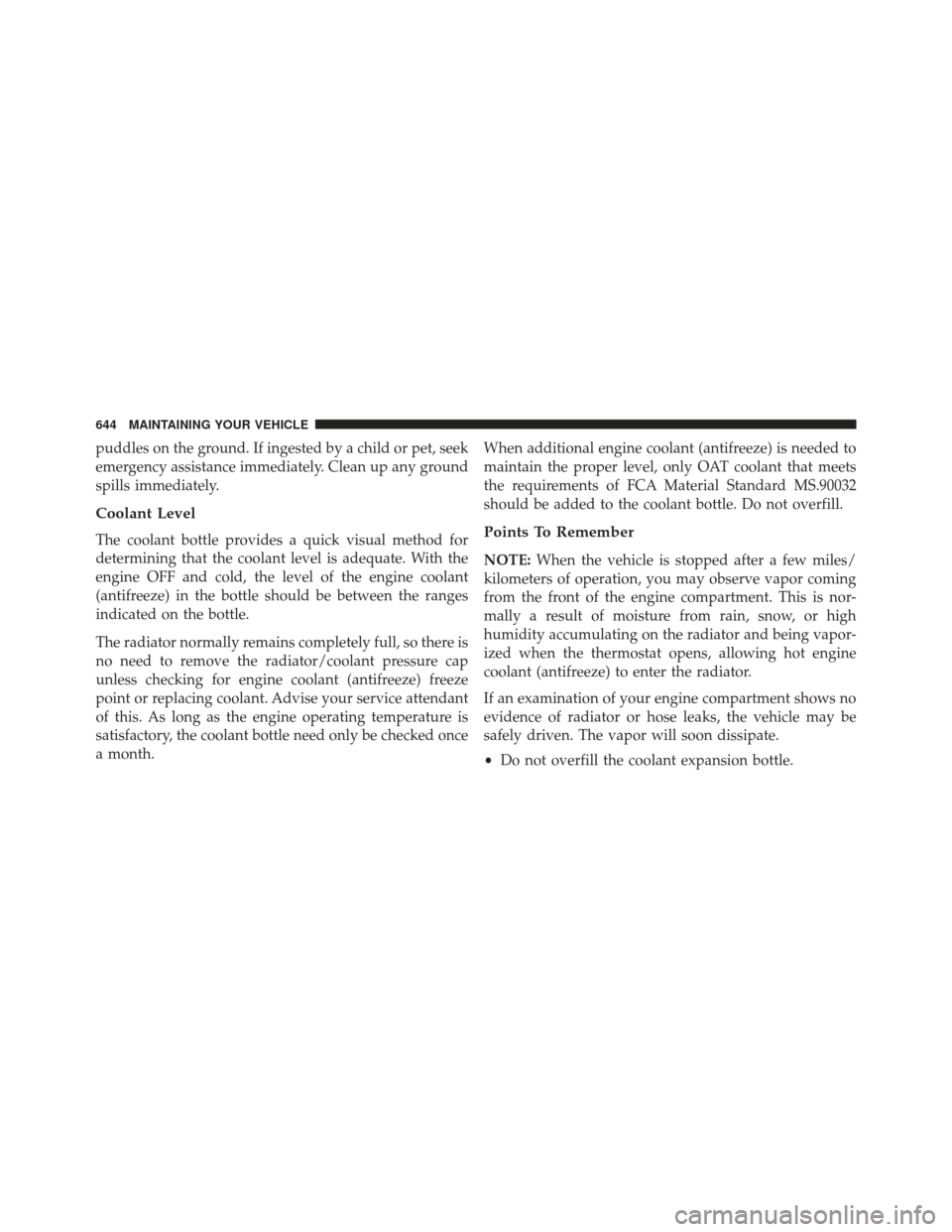
puddles on the ground. If ingested by a child or pet, seek
emergency assistance immediately. Clean up any ground
spills immediately.
Coolant Level
The coolant bottle provides a quick visual method for
determining that the coolant level is adequate. With the
engine OFF and cold, the level of the engine coolant
(antifreeze) in the bottle should be between the ranges
indicated on the bottle.
The radiator normally remains completely full, so there is
no need to remove the radiator/coolant pressure cap
unless checking for engine coolant (antifreeze) freeze
point or replacing coolant. Advise your service attendant
of this. As long as the engine operating temperature is
satisfactory, the coolant bottle need only be checked once
a month.When additional engine coolant (antifreeze) is needed to
maintain the proper level, only OAT coolant that meets
the requirements of FCA Material Standard MS.90032
should be added to the coolant bottle. Do not overfill.Points To Remember
NOTE:
When the vehicle is stopped after a few miles/
kilometers of operation, you may observe vapor coming
from the front of the engine compartment. This is nor-
mally a result of moisture from rain, snow, or high
humidity accumulating on the radiator and being vapor-
ized when the thermostat opens, allowing hot engine
coolant (antifreeze) to enter the radiator.
If an examination of your engine compartment shows no
evidence of radiator or hose leaks, the vehicle may be
safely driven. The vapor will soon dissipate.
• Do not overfill the coolant expansion bottle.
644 MAINTAINING YOUR VEHICLE
Page 677 of 723
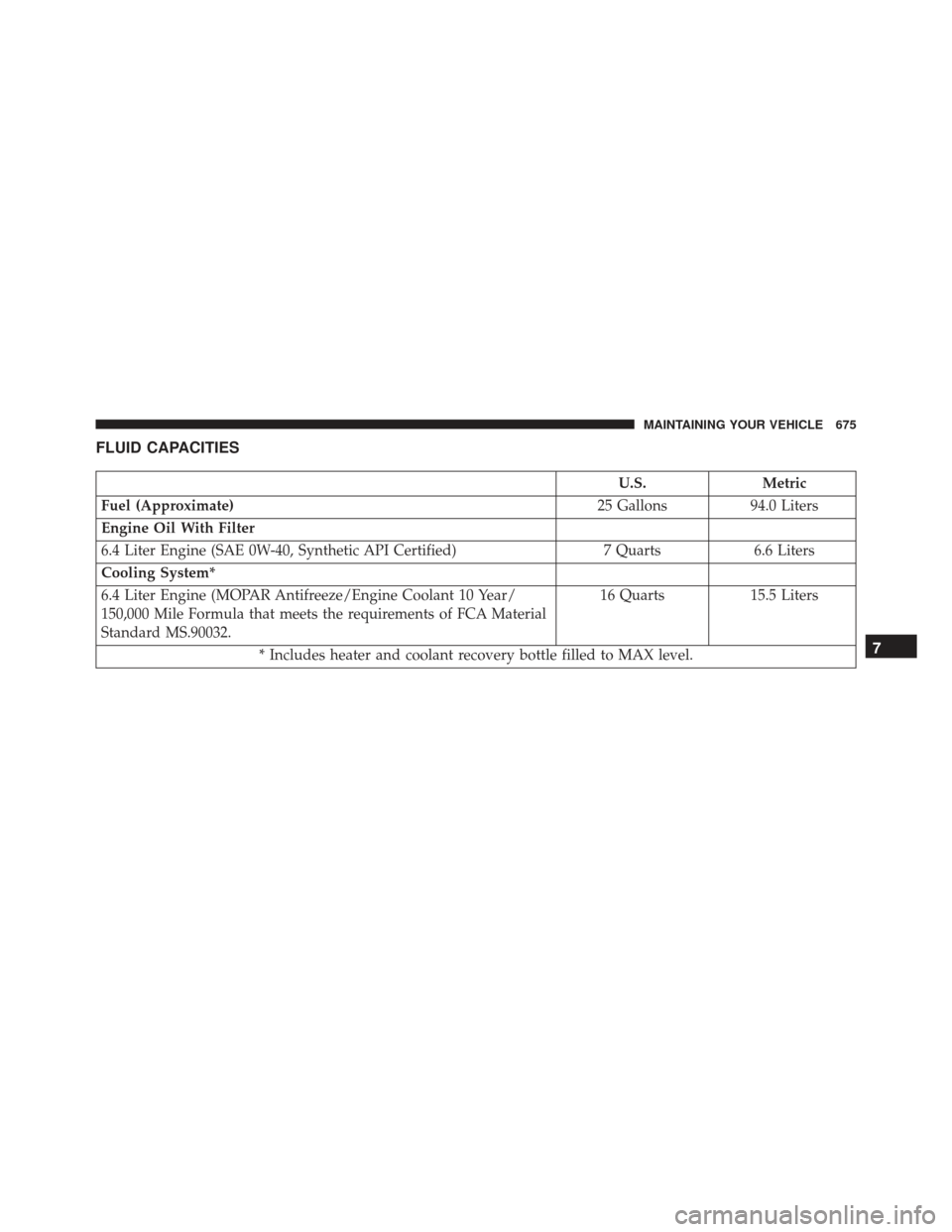
FLUID CAPACITIES
U.S.Metric
Fuel (Approximate) 25 Gallons94.0 Liters
Engine Oil With Filter
6.4 Liter Engine (SAE 0W-40, Synthetic API Certified) 7 Quarts6.6 Liters
Cooling System*
6.4 Liter Engine (MOPAR Antifreeze/Engine Coolant 10 Year/
150,000 Mile Formula that meets the requirements of FCA Material
Standard MS.90032. 16 Quarts
15.5 Liters
* Includes heater and coolant recovery bottle filled to MAX level.
7
MAINTAINING YOUR VEHICLE 675
Page 683 of 723
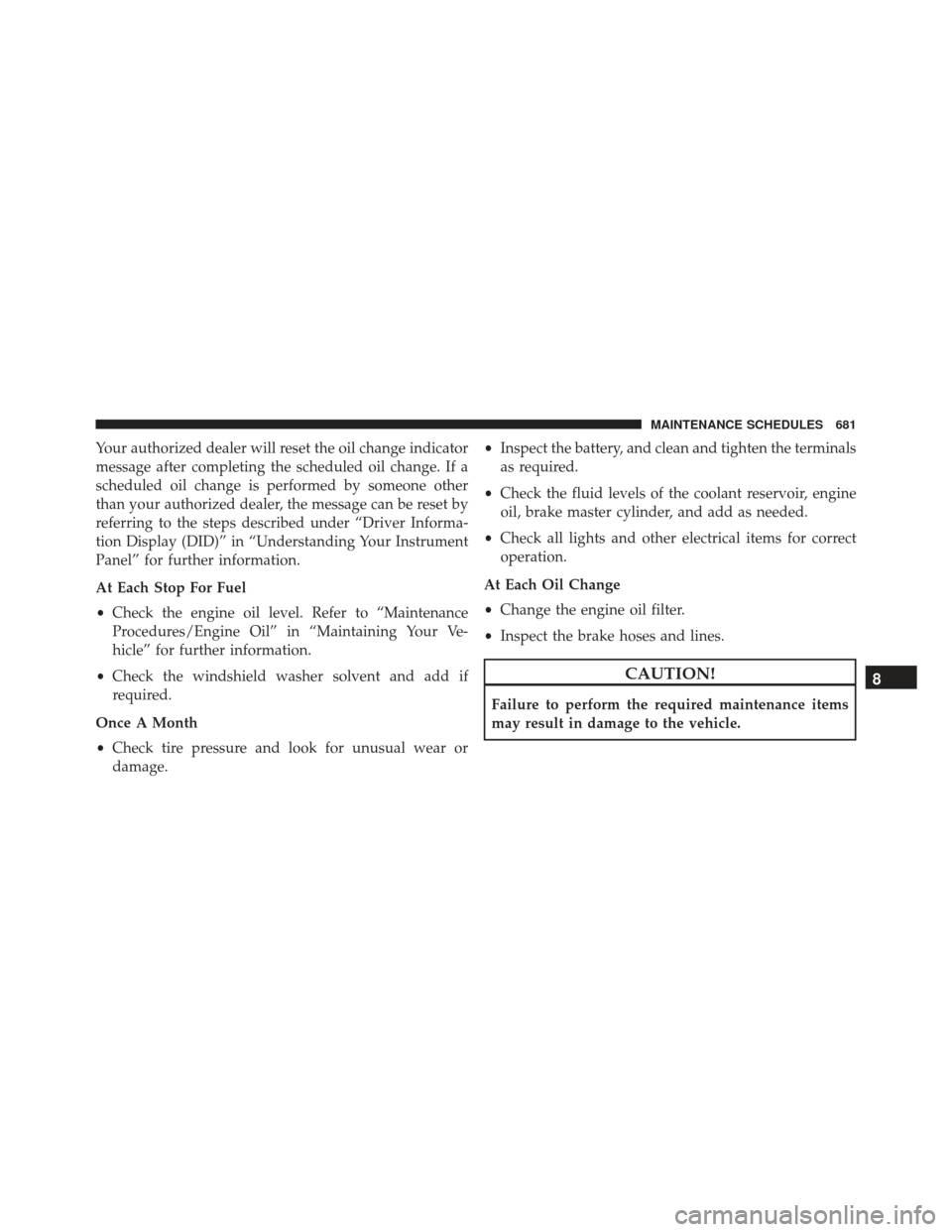
Your authorized dealer will reset the oil change indicator
message after completing the scheduled oil change. If a
scheduled oil change is performed by someone other
than your authorized dealer, the message can be reset by
referring to the steps described under “Driver Informa-
tion Display (DID)” in “Understanding Your Instrument
Panel” for further information.
At Each Stop For Fuel
•Check the engine oil level. Refer to “Maintenance
Procedures/Engine Oil” in “Maintaining Your Ve-
hicle” for further information.
• Check the windshield washer solvent and add if
required.
Once A Month
• Check tire pressure and look for unusual wear or
damage. •
Inspect the battery, and clean and tighten the terminals
as required.
• Check the fluid levels of the coolant reservoir, engine
oil, brake master cylinder, and add as needed.
• Check all lights and other electrical items for correct
operation.
At Each Oil Change
• Change the engine oil filter.
• Inspect the brake hoses and lines.
CAUTION!
Failure to perform the required maintenance items
may result in damage to the vehicle.
8
MAINTENANCE SCHEDULES 681
Page 703 of 723
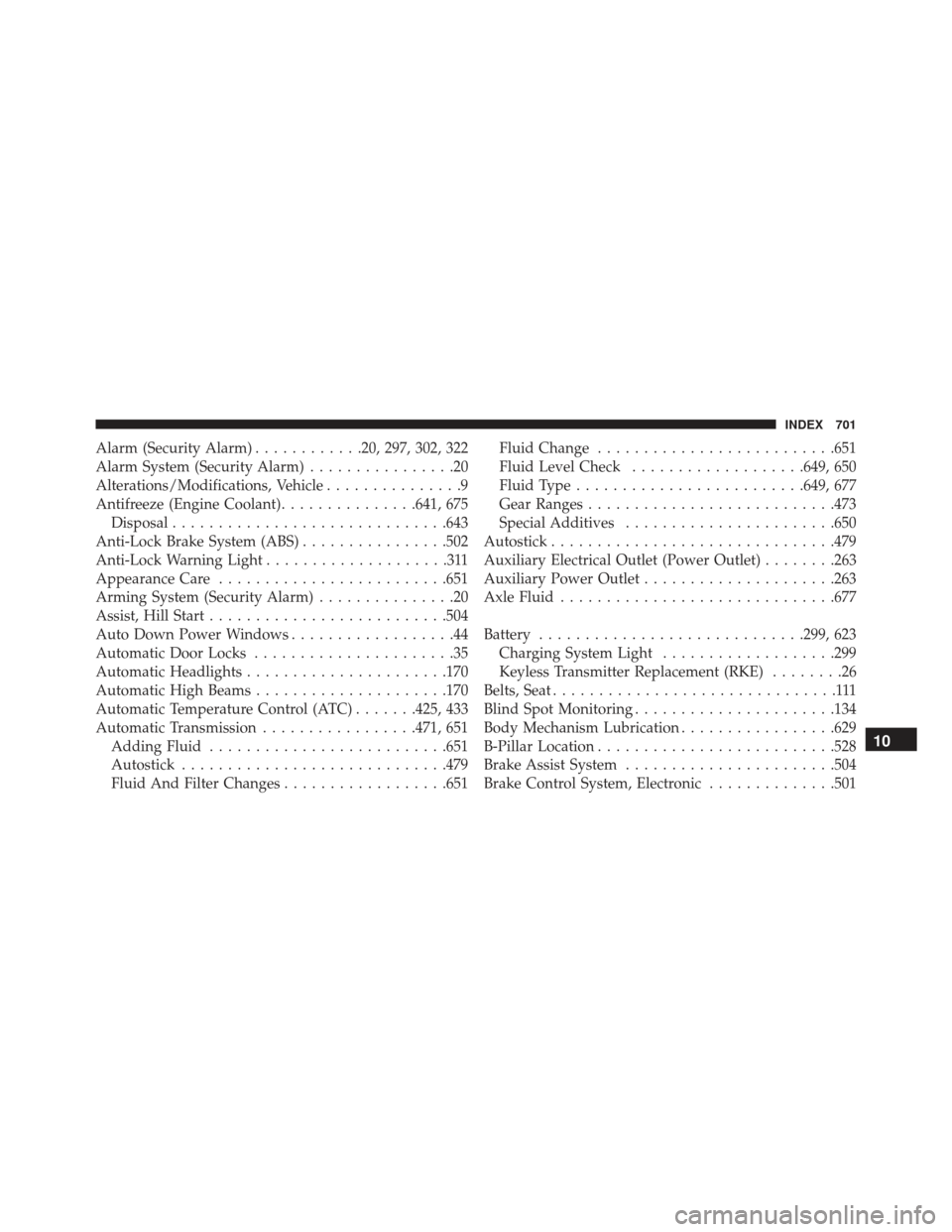
Alarm (Security Alarm)............20, 297, 302, 322
Alarm System (Security Alarm) ................20
Alterations/Modifications, Vehicle ...............9
Antifreeze (Engine Coolant) ...............641, 675
Disposal ............................. .643
Anti-Lock Brake System (ABS) ................502
Anti-Lock Warning Light ....................311
Appearance Care ........................ .651
Arming System (Security Alarm) ...............20
Assist, Hill Start ......................... .504
Auto Down Power Windows ..................44
Automatic Door Locks ......................35
Automatic Headlights ..................... .170
Automatic High Beams .....................170
Automatic Temperature Control (ATC) .......425, 433
Automatic Transmission .................471, 651
Adding Fluid ......................... .651
Autostick ............................ .479
Fluid And Filter Changes ..................651 Fluid Change
......................... .651
Fluid Level Check ...................649, 650
Fluid Type ........................ .649, 677
Gear Ranges .......................... .473
Special Additives ...................... .650
Autostick .............................. .479
Auxiliary Electrical Outlet (Power Outlet) ........263
Auxiliary Power Outlet .....................263
Axle Fluid ............................. .677
Battery ............................ .299, 623
Charging System Light ...................299
Keyless Transmitter Replacement (RKE) ........26
Belts, Seat ...............................111
Blind Spot Monitoring ..................... .134
Body Mechanism Lubrication .................629
B-Pillar Location ......................... .528
Brake Assist System ...................... .504
Brake Control System, Electronic ..............501
10
INDEX 701
Page 705 of 723
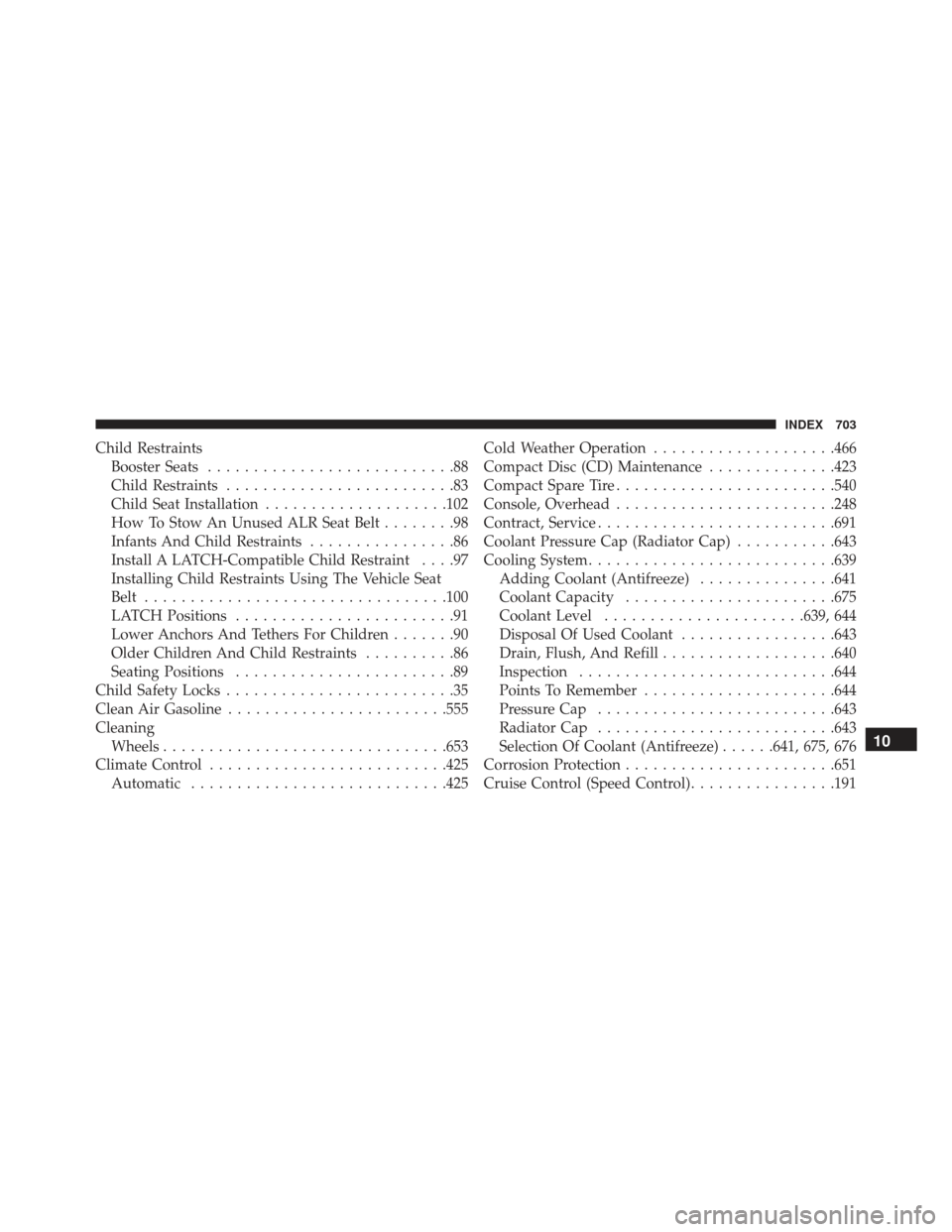
Child RestraintsBooster Seats ...........................88
Child Restraints .........................83
Child Seat Installation ....................102
How To Stow An Unused ALR Seat Belt ........98
Infants And Child Restraints ................86
Install A LATCH-Compatible Child Restraint ....97
Installing Child Restraints Using The Vehicle Seat
Belt ................................ .100
LATCH Positions ........................91
Lower Anchors And Tethers For Children .......90
Older Children And Child Restraints ..........86
Seating Positions ........................89
Child Safety Locks .........................35
Clean Air Gasoline ....................... .555
Cleaning Wheels .............................. .653
Climate Control ......................... .425
Automatic ........................... .425Cold Weather Operation
....................466
Compact Disc (CD) Maintenance ..............423
Compact Spare Tire ....................... .540
Console, Overhead ....................... .248
Contract, Service ......................... .691
Coolant Pressure Cap (Radiator Cap) ...........643
Cooling System .......................... .639
Adding Coolant (Antifreeze) ...............641
Coolant Capacity ...................... .675
Coolant Level ..................... .639, 644
Disposal Of Used Coolant .................643
Drain, Flush, And Refill ...................640
Inspection ........................... .644
Points To Remember .....................644
Pressure Cap ......................... .643
Radiator Cap ......................... .643
Selection Of Coolant (Antifreeze) ......641, 675, 676
Corrosion Protection ...................... .651
Cruise Control (Speed Control) ................191
10
INDEX 703
Page 707 of 723
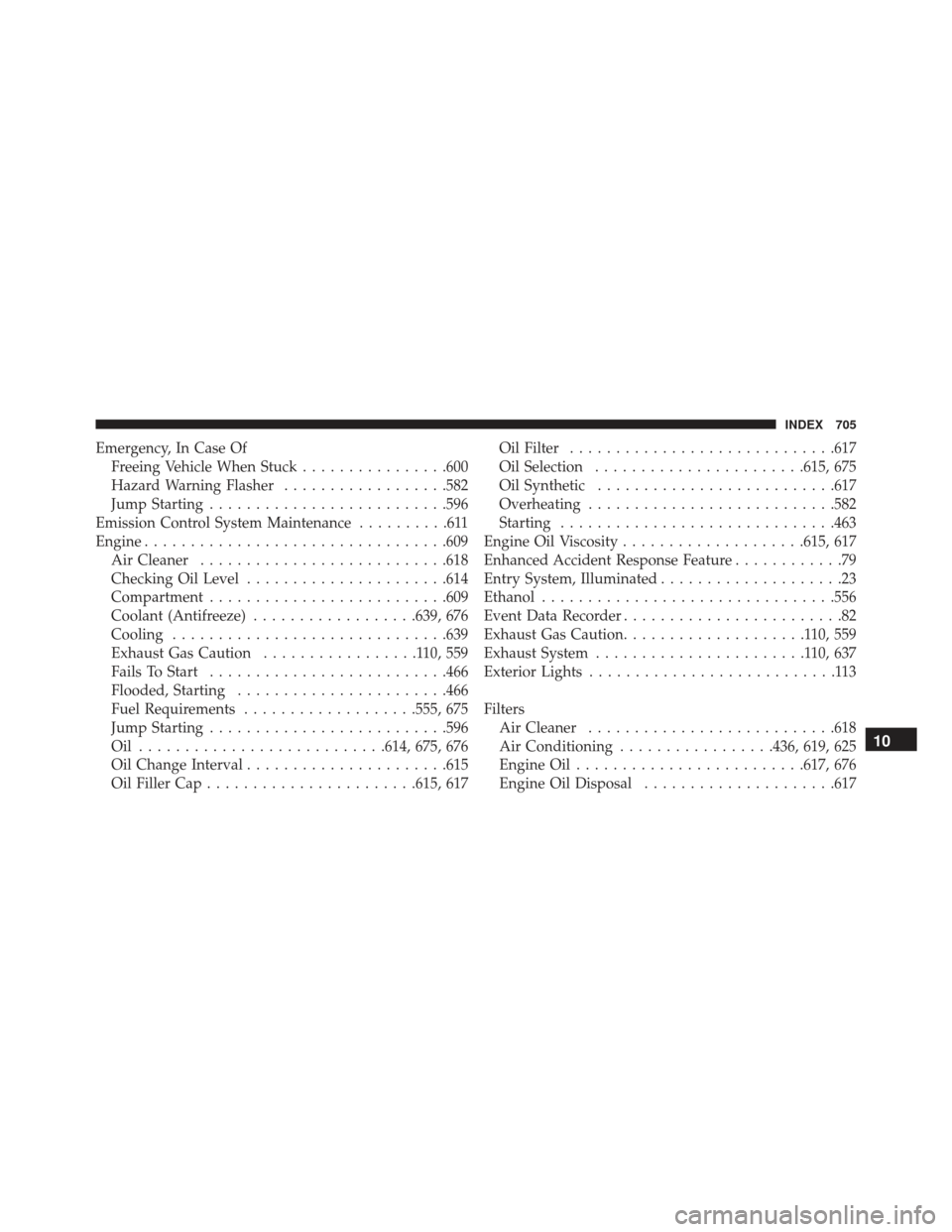
Emergency, In Case OfFreeing Vehicle When Stuck ................600
Hazard Warning Flasher ..................582
Jump Starting ......................... .596
Emission Control System Maintenance ..........611
Engine ................................ .609
Air Cleaner .......................... .618
Checking Oil Level ..................... .614
Compartment ......................... .609
Coolant (Antifreeze) ..................639, 676
Cooling ............................. .639
Exhaust Gas Caution .................110,559
Fails To Start ......................... .466
Flooded, Starting ...................... .466
Fuel Requirements ...................555, 675
Jump Starting ......................... .596
Oil .......................... .614, 675, 676
Oil Change Interval ..................... .615
Oil Filler Cap ...................... .615, 617Oil Filter
............................ .617
Oil Selection ...................... .615, 675
Oil Synthetic ......................... .617
Overheating .......................... .582
Starting ............................. .463
Engine Oil Viscosity ....................615, 617
Enhanced Accident Response Feature ............79
Entry System, Illuminated ....................23
Ethanol ............................... .556
Event Data Recorder ........................82
Exhaust Gas Caution ....................110,559
Exhaust System .......................110,637
Exterior Lights ...........................113
Filters Air Cleaner .......................... .618
Air Conditioning .................436, 619, 625
Engine Oil ........................ .617, 676
Engine Oil Disposal .....................617
10
INDEX 705